9.2 /10 1 Votes
Director(s) Masahiro Sakurai Genre(s) Action, platforming Initial release date 23 March 1993 Series Kirby | 4.6/5 Emuparadise Composer(s) Hirokazu Ando Mode(s) Single-player Publisher Nintendo Developers Nintendo, HAL Laboratory | |||||||||||||||||||||||||||||||||
 | ||||||||||||||||||||||||||||||||||
Producer(s) Satoru Iwata
Shigeru Miyamoto
Takao Shimizu Platforms Nintendo Entertainment System, Wii, Nintendo 3DS, Wii U, Game Boy Advance Designers Masahiro Sakurai, Satoru Iwata, Shigeru Miyamoto Similar Kirby games, Nintendo games, Platform games | ||||||||||||||||||||||||||||||||||
Nes longplay 063 kirby s adventure
Kirby's Adventure is a 1993 action-platform video game developed by HAL Laboratory and published by Nintendo for the Nintendo Entertainment System video game console. It is the only NES game in the Kirby series, and the second after his debut on the Game Boy in Kirby's Dream Land. It also features the first appearance of Meta Knight. A remake of the game for the Game Boy Advance, titled Kirby: Nightmare in Dream Land, was released in 2002. Kirby's Adventure was re-released on the Wii via the Virtual Console in February 2007. A 3D Classics version was released for the Nintendo 3DS eShop in November 2011 and a Virtual Console version for the Wii U was released in April 2013.
Contents
- Nes longplay 063 kirby s adventure
- Kirby s adventure wii episode 01 it s a kirby game
- Gameplay
- Plot
- Visuals
- Music
- Remakes and ports
- Reception and legacy
- References
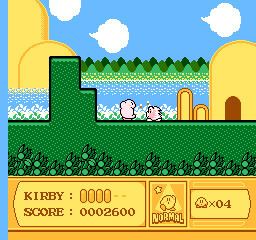
Kirby s adventure wii episode 01 it s a kirby game
Gameplay
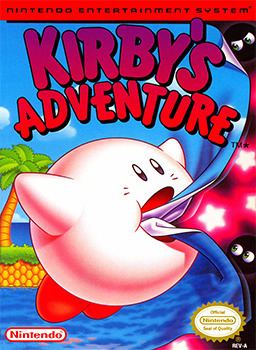
Like the majority of Kirby video games, Kirby's Adventure is a platformer. The game consists of seven worlds, each containing a set of regular levels, a boss fight, and a Warp Star door which enables Kirby to travel from world to world. Most worlds also contain mini-games which allow Kirby to gain extra lives, museums where Kirby may gain certain powers, and/or Arenas where Kirby must battle with a mini-boss to win health items and allow him to copy the boss' special ability. The game was the first in the series to include a save feature and it automatically saves the player's progress after each level.
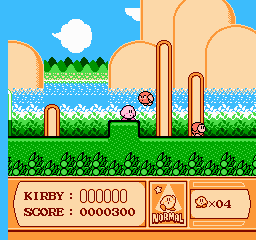
The objective of each main level is simply to reach its end. If Kirby touches an enemy or a dangerous object, he takes a point of damage, and if all of his hit points are lost or he falls off the bottom of the screen, the player loses a life. Kirby can touch or eat food items to immediately replenish health or gain temporary invulnerability.

Kirby can walk, run, jump, and he can attack and dodge enemies by slide-tackling. He can also fly by inflating himself, and is able to reach any height that isn't blocked by an obstacle. While flying, Kirby cannot use his other abilities, but he can exhale at any time, releasing a puff of air that can be used to damage enemies or destroy blocks.
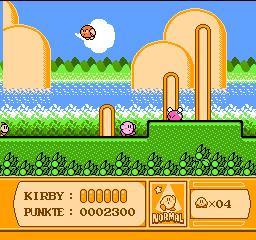
Kirby's main ability allows him to inhale indefinitely, sucking nearby enemies and objects into his mouth. Objects remain in his mouth until he either spits them out, dealing damage to enemies and objects in front of him, or swallows them. Upon swallowing certain enemies Kirby immediately "copies" any special abilities that the enemy possesses, some of which may be needed to solve puzzles. Usually, Kirby cannot inhale anything while he has use of a special ability. If the player presses the select button or if the character takes damage Kirby will lose his current ability and a star will bounce behind him for a short time. Kirby can regain the ability by inhaling and swallowing the star before it disappears.
Plot
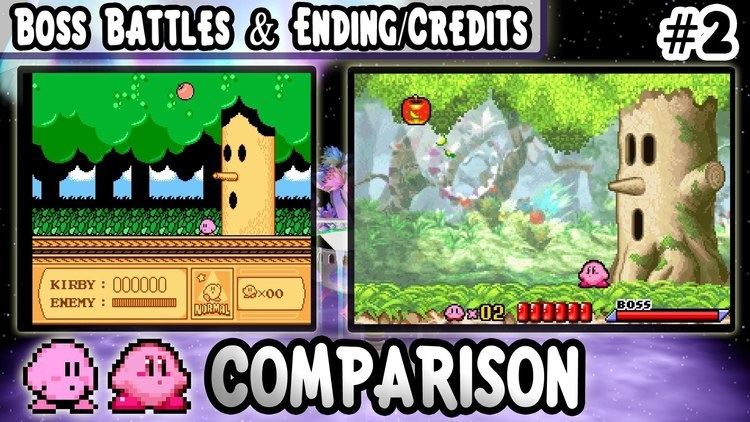
After waking up from his after-lunch nap without having any dreams, Kirby goes to the Fountain of Dreams to investigate. In doing so, he discovers that King Dedede has stolen the Star Rod, the source of the fountain's power, and broken it into seven pieces, giving six fragments to his allies, Whispy Woods, Paint Roller, Mr. Shine and Mr. Bright, Kracko, Heavy Mole, and Meta Knight, keeping one of the pieces for himself. Without the Star Rod, all of the inhabitants of Dream Land are becoming restless and unable to dream. Kirby decides to track down the fragments of the Star Rod and bring them back to the Fountain of Dreams in order to restore everyone's dreams.
Kirby travels throughout seven worlds, battling enemies, mini-bosses, and bosses through treacherous terrain in order to collect all seven fragments of the Star Rod. Once Kirby defeats King Dedede and rebuilds the Star Rod (with Dedede strangely begging him not to), he places it back into the Fountain of Dreams. However, an ominous black aura fills the skies as a dark creature, named Nightmare, emerges from the fountain. It turns out that Nightmare had corrupted the fountain, and King Dedede removed the Star Rod, broke it, and spread it across Dream Land with the intention of protecting Dream Land. Nightmare then speedily flies off into space, but rather than allowing him to escape, King Dedede inhales Kirby and the Star Rod and spits them into the air, projecting Kirby towards Nightmare. Kirby then uses the Star Rod to defeat both forms of Nightmare, and saves Dream Land once again. The end sequence shows Kirby and King Dedede flying together and reconciling, while scrolling text explains the aftermath of Nightmare's defeat. Before the end credits roll, Kirby waves the player good-bye while flying away on a Warp Star, breaking the fourth wall in the process.
Visuals
IGN remarked that "by 1993, the programmers of the world had learned how to unleash every last ounce of power hidden inside the original Nintendo system. Kirby's Adventure was one of those late-generation games, and probably the best of them." The game features special visual effects, pseudo-3D backgrounds, including towers that appear to rotate in three dimensions, and parallax scrolling. At 6 megabits, it was one of the largest games ever released for the NES; even so, it did not use Nintendo's most powerful mapper chip, the MMC5, but rather the older, more common, and less expensive MMC3.
Music
An official soundtrack was released in Japan on 21 July 1994, by Sony Music Entertainment Japan. The vocalist was Mako Miyata.
Remakes and ports
For Kirby's 10th Anniversary Kirby's Adventure was remade for the Game Boy Advance as Kirby: Nightmare in Dream Land; released in Japan on October 25, 2002, and North America on December 2, 2002. Nightmare in Dream Land features updated graphics and sound, as well as some minor changes to the gameplay, 3 new mini-games, and cooperative multiplayer with 2-4 players, as different-colored Kirbys.
Kirby's enigmatic rival, Meta Knight is a playable character in a new sub-game Meta Knightmare. In Meta Knightmare the player plays as Meta Knight racing to complete the levels from the main game in one sitting as fast as possible using Meta Knight's unique abilities. The player's fastest time is saved at the end. Meta Knight only has half the vitality of Kirby but he also runs much faster than Kirby, can ascend faster with his flight, and can break tough blocks and light cannon fuses with his sword's aura.
The original Kirby's Adventure was later released on the Wii Virtual Console on February 12, 2007 in North America, February 16, 2007 in PAL territories, and February 27, 2007 in Japan. It was also released on November 17, 2011 in the US and Europe and April 25, 2012 in Japan for the Nintendo 3DS as a part of the 3D Classics series, a series of classic games played in 3D. This release was featured amongst other games from the Nintendo Entertainment System and Super NES to be released for the 3DS on a tech demo called Classic Games at E3 2010. Both the original NES and GBA remake were released on the Wii U Virtual Console. The original NES was released in 2013. The GBA remake was released in 2014. For Kirby's 20th anniversary, Nintendo released Kirby's Dream Collection for the Wii. Kirby's Adventure is one of the games included in the disc.
Reception and legacy
Kirby's Adventure received widespread critical acclaim. The four reviewers of Electronic Gaming Monthly unanimously recommended the game for its intelligent level design and the huge variety of techniques employed in using Kirby's various abilities. They later awarded it Best NES Game of 1993. GamePro gave it a perfect score and called it "one of the best 8-bit games ever", citing the massive size of the cartridge, the imaginative enemies, the copy ability, the use of graphical effects not normally seen in 8-bit games, and the simple and smooth controls.
In 2009, the Official Nintendo Magazine named this game the 69th-best game ever on a Nintendo console. GamesRadar ranked it the 11th best NES game ever made, explaining that "Taking the concepts created in the first Dream Land game, Adventure expanded on them in great detail, including introducing Kirby's now-famous ability to copy his enemies’ powers."
The GBA remake received "favorable" reviews according to the review aggregation website Metacritic. In Japan, Famitsu gave it a score of 35 out of 40.
Reviewing the Virtual Console release, GameSpot criticized the short length of the game, but praised the high quality graphics and audio, the programming tricks used to emulate graphical effects that the NES was not actually capable of, and especially Kirby's numerous abilities for meeting challenges. They further remarked that despite over a decade having passed since its original release, "the game hasn't lost much of its charm or fun". Though they also criticized the lack of longevity, IGN wrote that Kirby's Adventure "is one of the best games to ever come from the NES", praising the graphics, the vast variety and universal enjoyability of the copy abilities, the creatively hidden secret areas, and the general fun of the game. They recommended it even for gamers who had already played the Game Boy Advance remake.
The 3D Classics version also received "generally favorable reviews" according to Metacritic.
